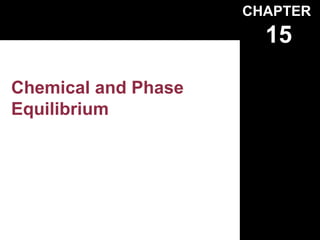Cengel ch15
- 1. CHAPTER 15 Chemical and Phase Equilibrium
- 2. Copyright ÂĐ The McGraw-Hill Companies, Inc. Permission required for reproduction or display. FIGURE 15-1 A reaction chamber that contains a mixture of CO2, CO, and O2 at a specified temperature and pressure. 15-1
- 3. Copyright ÂĐ The McGraw-Hill Companies, Inc. Permission required for reproduction or display. FIGURE 15-2 Equilibrium criteria for a chemical reaction that takes place adiabatically. 15-2
- 4. Copyright ÂĐ The McGraw-Hill Companies, Inc. Permission required for reproduction or display. FIGURE 15-3 A control mass undergoing a chemical reaction at a specified temperature and pressure. 15-3
- 5. Copyright ÂĐ The McGraw-Hill Companies, Inc. Permission required for reproduction or display. FIGURE 15-4 Criteria for chemical equilibrium at a specified temperature and pressure. 15-4
- 6. Copyright ÂĐ The McGraw-Hill Companies, Inc. Permission required for reproduction or display. FIGURE 15-5 An infinitesimal reaction in a chamber at constant temperature and pressure. 15-5
- 7. Copyright ÂĐ The McGraw-Hill Companies, Inc. Permission required for reproduction or display. FIGURE 15-7 Three equivalent Kp relations for reacting ideal-gas mixtures. 15-6
- 8. Copyright ÂĐ The McGraw-Hill Companies, Inc. Permission required for reproduction or display. FIGURE 15-9 The larger the KP, the more complete the reaction. 15-7
- 9. Copyright ÂĐ The McGraw-Hill Companies, Inc. Permission required for reproduction or display. FIGURE 15-10 The presence of inert gases does not affect the equilibrium constant, but it does affect the equilibrium composition. 15-8
- 10. Copyright ÂĐ The McGraw-Hill Companies, Inc. Permission required for reproduction or display. FIGURE 15-11 Equilibrium-constant relation for the ionization reaction of hydrogen. 15-9
- 11. Copyright ÂĐ The McGraw-Hill Companies, Inc. Permission required for reproduction or display. FIGURE 15-14 The number of KP relations needed to determine the equilibrium composition of a reacting mixture is the difference between the number of species and the number of elements. 15-10
- 12. Copyright ÂĐ The McGraw-Hill Companies, Inc. Permission required for reproduction or display. FIGURE 15-16 Exothermic reactions are less complete at higher temperatures. 15-11
- 13. Copyright ÂĐ The McGraw-Hill Companies, Inc. Permission required for reproduction or display. FIGURE 15-18 A liquidâvapor mixture in equilibrium at a constant temperature and pressure. 15-12
- 14. Copyright ÂĐ The McGraw-Hill Companies, Inc. Permission required for reproduction or display. FIGURE 15-20 A multicomponent multiphase system is in phase equilibrium when the specific Gibbs function of each component is the same in all phases. 15-13
- 15. Copyright ÂĐ The McGraw-Hill Companies, Inc. Permission required for reproduction or display. FIGURE 15-21 Equilibrium diagram for the two-phase mixture of oxygen and nitrogen at 0.1 MPa. 15-14
- 16. Copyright ÂĐ The McGraw-Hill Companies, Inc. Permission required for reproduction or display. FIGURE 15-22 Unlike temperature, the mole fraction of species on the two sides of a liquidâgas (or solidâgas or solidâliquid) interface are usually not the same. 15-15
- 17. Copyright ÂĐ The McGraw-Hill Companies, Inc. Permission required for reproduction or display. FIGURE 15-23 Dissolved gases in a liquid can be driven off by heating the liquid. 15-16

















